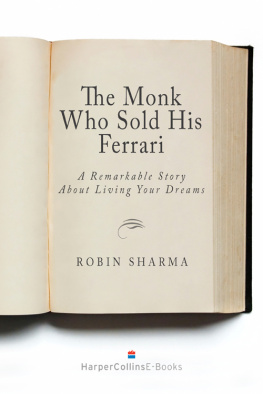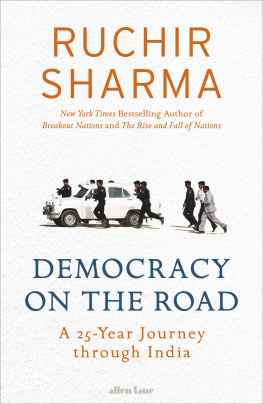Ayurvedic Healing
Contemporary Maharishi Ayurveda Medicine and Science
Second Edition
Hari Sharma, MD, FRCPC, DABHM and Christopher Clark, MD
Medical Editor: Marc S. Micozzi, MD, PhD
London and Philadelphia
Material in Chapter 6 from Sharma 2009 is reproduced by permission of AYU.
Material in Chapter 7 from Sharma 2002 is reproduced by permission of the Journal of Applied Nutrition.
This new edition published in 2012
by Singing Dragon
an imprint of Jessica Kingsley Publishers
116 Pentonville Road
London N1 9JB, UK
and
400 Market Street, Suite 400
Philadelphia, PA 19106, USA
www.singingdragon.com
First published in 1998 as Contemporary Ayurveda: Medicine and Research in Maharishi Ayur-Veda
by Churchill Livingstone
Copyright Hari Sharma and Christopher Clark 1998 and 2012
All rights reserved. No part of this publication may be reproduced in any material form (including photocopying or storing it in any medium by electronic means and whether or not transiently or incidentally to some other use of this publication) without the written permission of the copyright owner except in accordance with the provisions of the Copyright, Designs and Patents Act 1988 or under the terms of a licence issued by the Copyright Licensing Agency Ltd, Saffron House, 610 Kirby Street, London EC1N 8TS. Applications for the copyright owners written permission to reproduce any part of this publication should be addressed to the publisher.
Warning: The doing of an unauthorized act in relation to a copyright work may
result in both a civil claim for damages and criminal prosecution.
Library of Congress Cataloging in Publication Data
Sharma, Hari M.
Ayurvedic healing : contemporary Maharishi Ayurveda medicine and science / Hari Sharma and Christopher Clark ; medical editor, Marc S. Micozzi. -- 2nd ed.
p. cm.
Rev. ed. of: Contemporary Ayurveda / Hari M. Sharma and Christopher S. Clark.1998.
Includes bibliographical references and index.
ISBN 978-1-84819-069-6 (alk. paper)
1. Medicine, Ayurvedic. 2. Holistic medicine. I. Clark, Christopher, MD. II. Sharma, Hari M. Contemporary Ayurveda. III. Title.
R733.S53 2012
615.5'38--dc23
2011014613
British Library Cataloguing in Publication Data
A CIP catalogue record for this book is available from the British Library
ISBN 978 1 84819 069 6
eISBN 978 0 85701 063 6
Converted to eBook by EasyEPUB
Disclaimer
Medical knowledge is constantly changing. As new information becomes available, changes in treatment, procedures, equipment and the use of drugs become necessary. The authors and the publishers have, as far as it is possible, taken care to ensure that the information given in this text is accurate and up-to-date. However, readers are strongly advised to confirm that the information, especially with regard to drug usage, complies with latest legislation and standards of practice.
Acknowledgments
We would like first to express our deepest appreciation to Maharishi Mahesh Yogi for imparting his knowledge of consciousness and of Ayurveda.
Next, we wish to thank our families, for their constant love, patience, and support.
We would also like to thank the pre-eminent Ayurvedic vaidyas who have so generously shared their vast knowledge of Ayurveda with us, in particular Dr Brihaspati Dev Triguna, the late Dr Balraj Maharshi, the late Dr V. M. Dwivedi, Dr H. S. Kasture, Dr P. D. Subedhar, Dr Jaya Ramanuja Raju, and Dr Manohar Palakurthi. We are also grateful to the hundreds of physicians trained in Maharishi Ayurveda for their help in bringing out this knowledge. In particular, we wish to thank those leaders and initial proponents of Maharishi Ayurveda in the USA, Drs Richard Averbach and Stuart Rothenberg, for their pioneering efforts and for the knowledge they have made available to so many; Dr Tony Nader for his landmark discoveries about the connections of Vedic literature and the physiology; and Dr Barry Charles for his tireless efforts on behalf of Maharishi Ayurveda.
Finally, we are grateful to Barney Sherman, Robert and Patricia Oates, and Nick Sharma for their editorial assistance, and Linda Egenes and Ellen Kauffman for their research assistance.
Preface
Health care in the contemporary political entity of the state of India is a heterogeneous mix drawing on the medical traditions of both Asia and Europe as a legacy of its own history. Various medical systems and traditions are officially sanctioned and supported by the state.
The original medical tradition of the cultures indigenous to present-day India drew on Ayurveda, the way of life, or the science of life, or longevity. At once more and less than a medical system, Ayurveda is a prescription for living (with many proscriptions as well). From this philosophy of life derived from ancient teachings and wisdom a medical system can be articulated. As a somewhat loosely organized set of traditions, the medical aspects of Ayurveda may be highly individuated among patients and practitioners, and to some extent the line between what allopathic medicine might traditionally consider a patient versus a practitioner is somewhat blurred.
During successive occupations of India by Islamic Persian (Moghul), and then European rulers, the traditions of Ayurveda were lost or actively suppressed, and other medical traditions were introduced. To the extent that Ayurveda ever represented an integrated system, it became somewhat disintegrated. Contemporary Ayurveda as treated in this text represents a conscious attempt to revive and reconstruct some principles and practices of Ayurveda (a kind of cultural revival or restoration), to present it as an integrated system and to interpret it in the light of some contemporary theories of fundamental science that reach beyond Newtonian mechanics and typological biology (what I have called pre-Darwinian biology) as an explanation of health.
This particular system of Ayurveda is a fully articulated system that is manifest in its theoretical constructs, body of knowledge, training, and practice and is increasingly available in providing clinical services in Europe and North America. The system described in this text has made a conscious effort to consider the culture and society of contemporary Europe and North America in designing and delivering the type of health care described.
Therefore, this book provides a representation of how Ayurveda as a medical system may be encountered in North America and Europe today. Other Ayurvedic traditions are also encountered today, but are generally not integrated in the manner described above. In India, individual traditions of Ayurveda still flourish alongside Islamic medical traditions, homeopathy (introduced by European physicians during the last century) and allopathic medicine as found in contemporary North America and Europe. It is hard to say which system is dominant in India, and the political state makes no such distinction. The Indian population freely picks and chooses from among different medical traditions depending upon their needs and the availability of resources. This heterogeneous mix serves the second largest national population in the world.
This reality may be a reflection of the recognition that allopathic medicine is neither an appropriate nor an affordable medical technology for many situations. Another view may suggest that the present situation in India, while lower cost than in the West, is associated with a lower standard of medical care. The historical antecedents of the present-day health and nutritional status of the Indian population may be discussed and debated with respect to the role of European contact; the net result is a health care system which actively draws on both Asian and European traditions as a kind of popular medicine in India, and which has provided the basis for a contemporary system that is widely available and increasingly popular in North America and Europe.


















